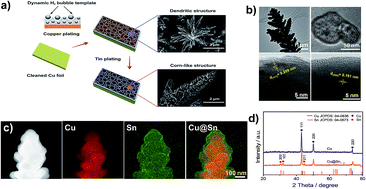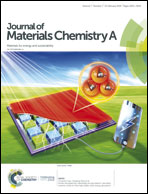3D core–shell porous-structured Cu@Sn hybrid electrodes with unprecedented selective CO2-into-formate electroreduction achieving 100%†
Abstract
Cu-based catalysts are exceptionally advantageous for the electrochemical CO2 reduction reaction (CO2RR) to fuels and chemical products utilizing clean and renewable energy. However, most tend to yield a diversity of hydrocarbon products along with the H2 evolution side reaction. We reveal how a 3D core–shell porous-structured Cu@Sn hybrid electrode can lead to an unprecedented selective CO2 electroreduction to HCOO−. Such an advantageous architecture is assembled via an in situ electrodeposition protocol using a dynamic hydrogen bubble template, rendering an enlarged electrode surface area when evaluated as an electrode material for the CO2RR. Notably, the best performing electrode, i.e., Cu@Sn(1), achieved a reduction current density of 55 mA cm−2 at −1.33 V vs. RHE, and an extremely encouraging Faradaic efficiency of 100% at an applied potential −0.93 V vs. RHE, accompanied by a partial current density of 16.52 mA cm−2. Moreover, it manifested a remarkably stable operation for over 15 hours of continuous electrolysis in aqueous KHCO3 solution. Numerically solving mass transfer equations and the Butler–Volmer equation show how the optimized presence of granular structured Sn on the surface of Cu was found to be the key for enhancing the HCOO− selectivity and the mass activity.



 Please wait while we load your content...
Please wait while we load your content...